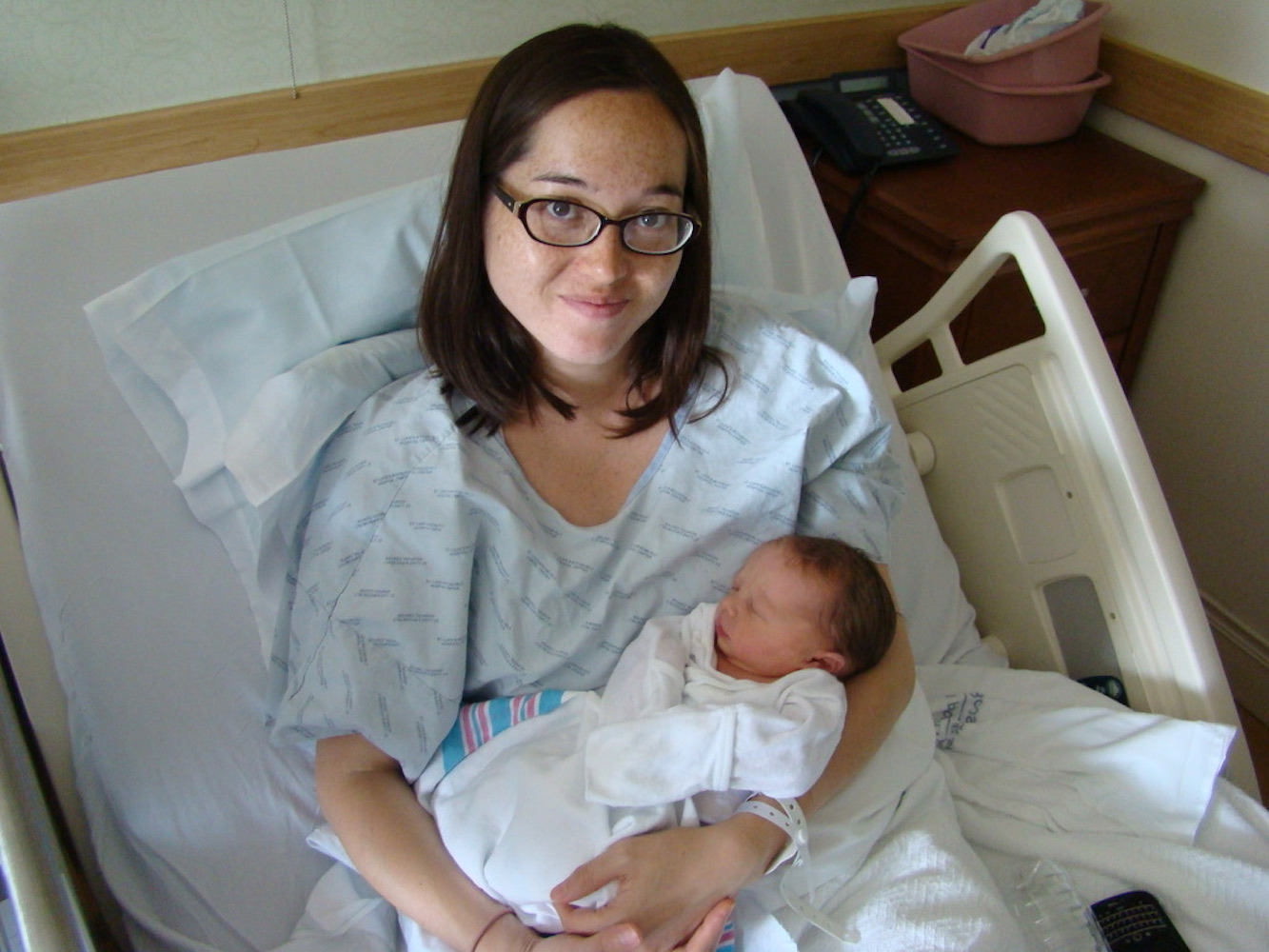
I found out my eldest daughter was breech during an ultrasound at 37 weeks. I remember the matter-of-factness of the ultrasound tech. I waited until she left the room to cry into my husband's dress shirt while sitting in a chair with a green cushion that had been smoothed by the weight of many parents-to-be before me.
Cesarean delivery is performed in about 90 percent of breech presentations—aka when the baby's butt or feet are closest to the cervix. I had been hoping to have an unmedicated birth, so I spent hours reading the Spinning Babies website. I tried all the things my OB belittled—lying upside down on our ironing board while shining a flashlight below my bump, acupuncture, the Webster technique, moxibustion—but my daughter's stubbornness prevailed.
Then the final medical attempt: an external cephalic version (ECV).
"I was getting so cocky! My last two worked." Those were my OB's words after his painful manipulations to force the baby to somersault were unsuccessful. Then he left the operating room. These are not the words you utter to a woman who is cold and naked, splayed out like a frog for dissection, the anesthesia kicking in too late. Back in his office a few days later, he asked me when we could schedule a C-section.
Switching Doctors While Nearing Full Term
After getting a referral from my prenatal yoga teacher, I switched OBs at 38 weeks. My friends were alarmed, my mother incredulous. Yet, when I met my current doctor, I just knew I made the right decision. She was among a dwindling breed within her field still trained in breech vaginal delivery. She also attended all of her patients' births, planning her vacations around due dates.
The day I met my doctor, she measured me inside and out. She listened and answered all of my questions. After months of perfunctory checkups with my ex-OB, it was comforting to feel so seen. My new doctor had gushing letters from patients taped to her cabinet doors. (Two years later, pregnant with a head-down baby, I would see my own handwriting hanging there!)
A decision chart on UpToDate showed that I was a favorable candidate for breech delivery: Frank breech (baby's legs are straight up in a V shape with feet by the head), past 36 weeks, with a provider skilled in breech delivery and the ability to have an emergency C-section if needed. I also had the financial privilege and flexible insurance coverage that allow for these choices.
My doctor discussed the risks of a breech vaginal delivery with me, including the baby's shoulders getting stuck, umbilical cord prolapse, and hip dysplasia. Jean Fechheimer, M.D., an OB-GYN at Mount Auburn Hospital in Cambridge, Massachusetts who wasn't a part of my medical team, says, "There are known potential risks associated with vaginal breech delivery. But if it is done in a place where people are adequately trained, then serious complications should be rare."
I then asked my doctor what I should be prepared for, and she told me that if it became clear my daughter's head could not be safely delivered, she would push the body back inside me and perform a C-section.
The Day of My Breech Delivery
A week and a half after meeting my new doctor and three days before my due date, I went into labor. My labor progressed in ways that minimized the risk of complications: spontaneous and without slowing, strong fetal heart rate that was continuously monitored. I declined an epidural. As I felt a tremendous urge to bear down during transition, my doctor told me when to breathe and push and when to wait. My husband and doula each held one of my legs aloft.
At times, my doctor had her hand inside me to check on and reposition the baby. This intensified the pain, and our doula coached me through it. It was quite a full room as there were several residents and med students observing the procedure that has become quite rare. In fact, even 40 year ago when she was a resident, Dr. Fechheimer says there were "limited opportunities" to do breech deliveries.
My doctor's coaching and expert manipulations of the baby ushered my firstborn's bum, then legs, then torso out of me. We were now in the pivotal moment. The pain was intense, but I focused on my doctor, trying to block out the voice of one the residents who was yelling at me (not helpful). Two more pushes, and she was out.
I remember asking if my husband would cut the umbilical cord and a firm "No" came from my doctor. I didn't know at the time, still reveling in the ecstatic cessation of pain, that my daughter's first moments on the outside were quiet. There was not the immediate cry that's heard in TV and movie birth scenes. Our doula later told me that my daughter was not breathing when she emerged and that my doctor held her with calm concern until she filled her lungs with outside air for the first time.
Next, the pediatrician who had been on hand (another bullet point in the decision tree), took the baby to the corner of the room to examine her. In my memory, all of the post-birth events collapse into an instant, and I all see is my daughter, sticky and squinting, being placed onto my sweaty, freckled chest. I am holding her, taking a photo with my doctor while my husband, still queasy from seeing so much blood, worked to regain his composure on the couch next to my bed.
Life After My Breech Delivery
Shortly after she was born, my daughter was diagnosed with hip dysplasia. She had several factors that increased her risk: her sex, being the firstborn, and her breech position. A study by the British Society for Children's Orthopaedic Surgery found that method of birth impacts the incidence of hip dysplasia. It concluded that breech "infants delivered by normal vaginal delivery or emergency caesarean section had a significantly higher incidence of [hip dysplasia] than those delivered by elective caesarean section."
During her first hours on the outside, my daughter defaulted to her V-shaped position, taking her time getting accustomed to stretching her legs down. Thanks to the use of a Pavlik harness for the first 12 weeks of her life and then a hip abduction brace until she was 6 months old, her hip dysplasia has resolved. She's now a middle schooler with twice-weekly ballet classes and annual performances in the Nutcracker.
Ten years ago, I made a difficult decision. I hope that what all three of my girls will take away from the days that led up to my walking into my new doctor's office, is that sometimes you have to trust your gut, do what you feel is right for you, and advocate for yourself, even when doing so feels insurmountable.





